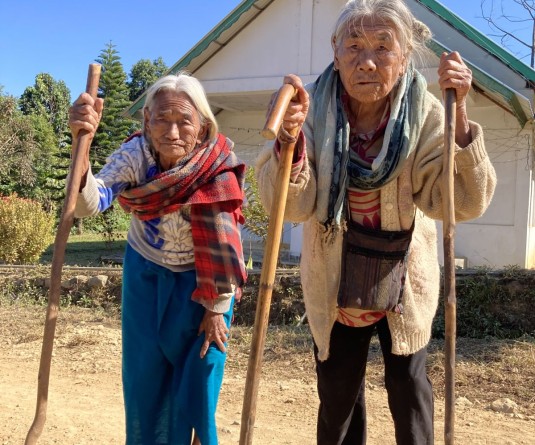
Transforming VGs for a Resilient Frontier Naga Territory
Dr Aniruddha Babar
Dept of Political Science, Tetso College
As I set foot in the picturesque landscapes of Frontier Nagaland, I was captivated by the raw beauty of the region and the vibrant culture, simplicity, openness and straightforward character of its people. It was during my expeditions in this enchanting yet one of the most backward regions of the world that I had the privilege of encountering the unsung heroes of the frontier villages—the Village Guards (VGs). These brave individuals, driven by a deep sense of duty, not only protect their villages and communities but also possess the potential to play a vital role in supporting the Assam Rifles in guarding the borders and maintaining law and order.
My curiosity led me to discover that in Tuensang district Helipong village has 20 village guards, Tuensang village 77, Chingmelen village 28, Buthenbou village 20 and Ngangpong village has 30 VGs till date. On the other hand, in Noklak district, Pang village has 60 village guards, Thonoknyu village 30, Chiliso village 25, Pathso village 19, Pathso Nokeng village 17, Sanglao village 37, Noklak village 35, Langnok village 50, Nokhu village 50, New Pangsha 36, Wonthoi 45, Old Pangsha village 25, Nokyan village 40 and Peshu village has 31 village guards. Also, in Kiphire District, Phelungre village has 40 village guards, Amahator village 34, Kiphire village 35, Langkok village 25 and Singrep village has 50 VGs while in Longleng district, Pongo village has 34 village guards.
During my travels to remotest of the regions in the eastern part of the Nagaland-which I proudly call my own, I had the opportunity to meet and forge close friendships with many Village Guards. Their dedication and commitment to the safety of their communities were truly remarkable. As we sat around bonfires, sharing stories and experiences (in Naga-Hindi, Nagamese also with the help of translators), I was struck by their unwavering resolve to protect their ancestral lands and preserve their way of life. These strong, ancient men, often with limited resources and training, stood tall as the guardians of their villages, bravely facing any challenges that came their way.
However, as I delved deeper into the security dynamics of the region, it became clear to me that the VGs needed to be modernized and equipped with the necessary tools to effectively carry out their duties. In the face of ever-evolving security threats, the heavy influence of China in neighboring Myanmar as well as Myanmar centered insurgency dynamics, it is imperative that the VGs are provided with modern weapons and technology to bolster their capabilities. This is not only crucial for the protection of their villages but also for supporting the Assam Rifles in their efforts to safeguard the borders and maintain law and order.
My interactions with the robust VGs revealed their eagerness to enhance their skills and learn new techniques to tackle emerging challenges. They expressed a genuine desire to collaborate with the Assam Rifles, exchanging knowledge and working together as a unified force. This synergy between the VGs and the Assam Rifles has the potential to create a formidable security network, ensuring the safety of the people and the integrity of the borders.
In the wake of the proposed Frontier Naga Territory, the role of the VGs will take on an altogether different dimension. This new administrative unit will demand a heightened level of vigilance and preparedness. The Village Guards, with their intricate knowledge of the local terrain and close ties to the communities, are poised to become the frontline defenders of this new territory. Their intimate understanding of the region's security dynamics and their unwavering commitment make them invaluable assets in ensuring the success of the Frontier Naga Territory.
To effectively modernize the VGs Force, a comprehensive policy approach is required. To modernize the VGs and elevate their capabilities, several key steps can be taken. First and foremost, let us learn to give them well deserved recognition and respect. Village Guard is not rich people’s ‘Chowkidar’ or Multi-Tasking Staff nor a ‘professional dancer’ in ‘Tribal Festivals’ he is a ‘paramilitary trooper’, let us not forget. VGs should be treated with dignity and honor by all. Providing village guard troops with sophisticated modern weapons is essential to boost their morale and operational capabilities. Equipping them with advanced firearms and communication devices will significantly enhance their ability to respond to security threats effectively In addition to weapons, updating their uniforms to a modern and attractive design can instill a sense of pride and professionalism among the Village Guards. A well-designed uniform not only boosts morale but also presents a unified and organized image.
Further, Investing in modern training programs is another crucial aspect of modernization. By introducing specialized training modules that focus on counterinsurgency tactics, reconnaissance, intelligence gathering and emergency response, the VGs can acquire the necessary skills to handle a wide range of security challenges.
Moreover, establishing a ‘squad’ size Commando Quick Reaction Team (QRT) with a young, robust, reasonably educated village guard as its commander, within the local ‘VGs Platoon’ can further enhance their capabilities. This specialized squad would undergo intensive training in counterterrorism as well as counterinsurgency tactics, rapid response and close-quarters combat. The QRT unit can serve as a rapid deployment force, capable of swiftly and effectively addressing emergencies and high-risk situations.
To motivate and retain talented individuals within the VGs Force, offering higher pay and improved benefits is essential. Adequate financial compensation not only acknowledges their crucial role in maintaining security but also helps to improve their standard of living and support their families. ‘Three Thousand Rupees’ per month salary is a mockery of the Village Guard system plus such ‘exploitation’ violates their constitutional rights. Moreover, there is no information about the committee that is supposed to be set up to finalize the pay and wages issue of Village Guards. It is important that pending issues be resolved without any delay to maintain the integrity and honor of ‘VGs Force’ looking at the complex dynamic changes in the ultra-sensitive Indo-Myanmar Border regions.
Finally, regular and ongoing training should be implemented to ensure that the VGs stay updated on the latest security techniques and remain prepared to face evolving threats. Conducting periodic refresher courses and workshops will enable them to maintain their skills, discipline and adapt to new challenges effectively.
By implementing these measures, the VGs can be modernized into a highly efficient and professional force. Equipped with sophisticated weapons, donning attractive uniforms, and supported by regular training, they will be better prepared to fulfill their responsibilities of protecting their villages, professionally supporting the Assam Rifles in guarding the borders, and maintaining law and order in the region while ably assisting the Police Force.
As someone who has deeply witnessed firsthand the unique security challenges faced by the region, I am acutely aware of the pressing need for a modernized VGs Force. As made informed during freewheel discussions and personal interactions, the fact to be considered is that the heavy Chinese influence (psychological, political, economic and strategic) in Myanmar as well as the possible strategic alliance of several insurgent outfits in Myanmar, poses a significant threat which is a matter of serious concern. By empowering the VGs Force with the necessary resources and support, we can build a robust security network that not only safeguards our villages and communities but also acts as a bulwark against external forces that seek to undermine our sovereignty.
In conclusion, my personal experiences and encounters with the VGs in Eastern Nagaland have highlighted the tremendous potential they possess. They are not merely protectors of their villages; they have the ability to support the Assam Rifles in guarding the borders and maintaining law and order. To unlock this potential, it is crucial to modernize the VGs by providing them with modern weapons, training, and support. The proposed Frontier Naga Territory presents an opportunity to reshape the role of the VGs and harness their expertise in safeguarding the new administrative unit. As we embark on this transformative journey, let us strive to create a new generation of VGs for a new frontier—strong, capable, and ready to defend our land, our people, and our shared future.
Amidst the rugged terrains of Frontier Nagaland, the VGs stand tall as the unsung heroes, the guardians of India's sovereignty. With unwavering commitment and indomitable spirit, they protect their villages and communities, defending the very essence of our nation. Their courage and sacrifice resonate through the valleys and echo in the mountains of Nagaland, reminding us of their invaluable role in safeguarding our frontiers and maintaining law and order.
In the company of my towering mountain comrades, there came a time when I crossed paths with a seasoned Village Guard, an ancient soul whose indomitable spirit shone through his weathered countenance, a testament to the challenges he had faced. As I prepared to depart from his watchful post with my local buddy, he stood firm, unwavering in his resolve, offering a salute that spoke volumes of his unwavering commitment. In that brief yet profound moment, his Naga styled Hindi words resonated within me, "Saab, humko bhulna nahi haa" (Sir, do not forget us).
In that profound moment of clarity, I comprehended my rightful position among their noble ranks, embodying the role of a protector for the people and the revered land. Filled with a sense of pride, I gazed upon him, straightened my posture, adjusted my cap and reciprocated his salute with equal “HONOUR”.




